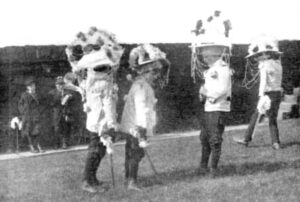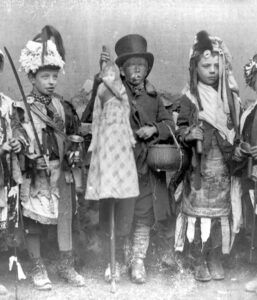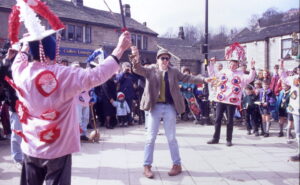Mumming plays, like so much of British folklore, have been subject to questionable assumptions as to their age and meaning, but today research has shed a clearer light on their origins and functions, as Eddie Cass describes.
Easter! Once again, hundreds of people from miles around – and further – will come into Hebden Bridge and Heptonstall to see the various performances of the pace-egg play, but just what is it that they are seeing? And, perhaps of more importance, what do they think that they are seeing?
The British folk or mumming play was once known over most of England except for East Anglia. It was known in lowland Scotland, where it is usually called Galoshins after the lead character, it was known in parts of Wales and parts of Ireland. In all, it has been recorded in some 1700 different locations. There are three principal sub-groups of folk plays. The largest of these is the so-called hero-combat play, which is the most geographically widespread version; here, a character, perhaps called the Fool, or Father Christmas, or Old Woman, comes in to introduce the actors. Two knights, perhaps St George and Bold Slasher, then come in and boast of their fighting skills; there is a sword fight, one of them is killed or mortally wounded and a doctor is called for. The Doctor comes in and works a cure by means of some magical potion and heals the wounded man. There may be one or two further fights, but rarely a second healing. Finally, a number of supernumerary characters come in, possibly Beelzebub, Dirty Bet or Devil Doubt, and a collection is taken. It is clear from the alternatives posited above that the text and cast list of these plays varies widely, even if the core of the action remains the same. The other groups of folk plays, the sword-dance plays of the NE and the plough plays of the East Midlands are not relevant to this article.
Over most of Britain, these plays were performed during the old Christmas season from just before Christmas to just after Plough Monday, around January 6th, which was the day on which the agricultural season notionally began again after the Christmas break. In this respect, the pace-egg play, a version of the hero-combat play – a version indigenous to NW England, and confined to Lancashire, Pennine Yorkshire and the southern parts of the Lake District – was unique in that it was always performed at Easter. Pace and paschal have the same linguistic roots. One other feature of the pace-egg plays adds to their unusual character. The texts of the vast majority of folk plays were passed on orally; they were rarely written down and when they were written down it was largely for the benefit of interested antiquarians or folklorists. Whilst there was an oral tradition in the NW, knowledge of the texts of the pace-egg play was supplemented by chapbooks which were printed widely in Lancashire and Yorkshire from the second quarter of the 19th century until the First World War. Towards the end of the 19th century, the Rochdale dialect poet, John Trafford Clegg (Th’Owd Weighver) wrote a vivid dialect sketch, ‘Bowd Slasher’, of a performance of the play in ‘th’oppen market’, Rochdale, a performance which is clearly based on a chapbook text.1 In this sketch, one of the actors is challenged about his words: “It’s deawn i’ th’book shuzeaw”, he replies and “poo’s his book eaut” to prove the point. Later, William Mitchell writing of his own experience in Rochdale before the Great War, stated that “…during the weeks prior to Easter it was no uncommon thing to see groups of boys gathered round in some backyard, or sitting out in the fields, rehearsing from the printed booklet the words of the familiar mummery”.2 From Yorkshire we have another record from just before the Great War:
[Annually] Starting in the village the performers gave their play and made a collection before moving on to the surrounding farms. Practically the spontaneous performance of the play gradually died out in the Calder Valley as elsewhere after 1879, but in Luddenden Valley it retained its vitality in the village of Midgley until it dwindled away at the outbreak of the first world war. I was fortunate enough to photograph one group of lads which Harry Waterworth found performing on Good Friday, 1913… Waterworth first dropped down to the Post Office at Luddenden and bought two copies at a halfpenny each, of the local version. This is a small leaflet of eight pages entitled, ‘The Peace Egg or St. George’s Annual Play for the Amusement of Youth’.3
At least one of the copies referred to, printed by John Harkness of Preston, is now held in the Opie Collection at the Bodleian Library; The title page is annotated: at the top, ‘W. B. Crump’, and, at the foot of the page, ‘Bought in Luddenden, & acted there Good Friday, March 21st 1913’.4 Crump was a well-known local historian in the Calder Valley and collected several versions of the text of the pace-egg play. He was a colleague of William Henry Harwood, who played a large part in the revival of the Midgley play in the 1930s.

Pace-Eggers in Midgley, 1913 (W B Crump)
Working under the influence of James Frazer and the Cambridge Ritualists, Jane Harrison, Gilbert Murray, Francis Cornford and the historian of the early stage, E. K. Chambers, late 19th and early 20th-century antiquarians and folklorists believed that these folk plays were survivals of pagan spring ceremonies. Today’s folk play scholars, however, take a much more historical view of the phenomenon. There is no evidence that the play was known before the first half of the 18th century, from around the 1730s, and it was always primarily what the social historian might call a legitimised wealth transfer transaction. It was not acceptable for a respectable member of the working classes to beg, but it was legitimate for them to sing, dance, play music or perform a play in exchange for food, drink or money, particularly at the time of festivals such as Christmas. This is a somewhat reductive view of folk plays and it ignores the fact that plays often had a community role and the actors, who were always men or older boys, felt privileged within their local society for their roles in the play. Moreover, we have recollections of old mummers which record the fact that they truly enjoyed the experience of performing the play. The play died out almost completely between the two world wars, and only six plays to be seen today, including the Midgley play, have roots in the 19th century, although the play was extensively revived in the post-Second World War folk revival.
It is with these revival teams that we can begin to see one reason for the persistence of the idea that the folk play has a ritual origin. Despite the fact that the folklore departments at both Leeds and Sheffield universities had been researching these plays from the 1970s and had come to the conclusion that there was no evidence for their existence before the 18th century, books which claimed that they had a ritual origin continued to be published until the 1980s. Cawte, Helm and Peacock’s English Ritual Drama was published by the Folklore Society in 1967;5 The English Mummers and their Plays, by Alan Brody, in 19696 and The English Mummers’ Play by Alex Helm, again published by the Folklore Society, in 1980 all posited a ritual origin for the English folk play. Indeed, two of the titles are redolent of a pagan origin for the phenomenon. It is, perhaps, unfair in a way to pick out this last title. Alex Helm was the leading British folk play scholar of the post-war generation, one who died tragically early in 1970 at the age of 50. Christopher Cawte, one of his colleagues, once told me that had Helm lived, he would surely have changed his views on the origin of the plays in the light of the research of the 1970s and 80s. Moreover, his book was written before his death, but took ten years to get into print.
Despite this last reservation, it is impossible to ignore the fact that it is the somewhat suspect theory which underpins the scholarship of these books and which was derived directly from the Victorian and Edwardian antiquarians which influenced many of the morris sides who revived the folk play in the late 1960s and early 70s. When conducting fieldwork amongst men who had performed the play, I used to ask what it was that they thought they were performing. One pace-egger typified the responses I got: “We bought into the Ritual side of it, bit doubtful about that now as I think people are generally… [but] We’d read the books”.7 Today, folk play teams often refer to the ancient or ritual origins of their plays. Heptonstall posters sometimes carry the legend “The Pace Egg play is perhaps the world’s oldest drama and can be traced back through English and European Mummers’ plays to ancient Egypt and Syria. A mixture of a Pagan rebirth ceremony with the later influences of Christianity and the Crusades”.8 Bury Pace-Eggers describe their play as, “…the ancient luck-bringing ceremony… A traditional ritual of Pagan origin, performed at Easter, in which the death of Winter and the rebirth of Spring are symbolized by the death and resurrection of one of the characters”.9 I believe that the original performers in the early Bury play were strongly influenced by a member of the Folklore Society. Given the persistence of myth/ritual theories among folklorists until the 1970s, it is not surprising that they passed on these false beliefs to many of those with whom they came into contact.
A second influence on the persistence of these now academically outmoded ideas is the continuing insistence of the media in seeking – and expounding – pagan origins for all the calendar customs they describe. I was recently invited to take part in a BBC ‘Heaven and Earth’ programme on the Rochester Sweeps Festival; the programme, along with the pre-recorded material from the festival, was dropped when I could not confirm that it was a pagan event when, in truth, it was a Victorian invention with possible roots in a 17th-century dairymaids’ begging custom. The researcher could not believe that morris dancers could not get up before dawn to dance unless they were practicing pagans. The idea that men and women could rise at that time for the sheer joy of dancing-in the dawn, irrespective of what religious persuasion they happened to be, seems to have escaped the researcher.
In the last two paragraphs I have tried to explain how the ritual origin theory of folk drama and other calendar customs is spread. But why should such ideas be so readily accepted? Folklorists no longer accept unquestioningly the survival beliefs expressed by Tylor or Frazer and their contemporaries. Indeed, the myth/ritual theory came in for sustained criticism in the early years of the 20th century, although it was potent enough to surface in a second phase from the 1930s-1960s. In the late 1960s, Fontenrose10 again attacked the so-called evidence used by Frazer and his later disciples. His critique of the second phase of myth/ritualism demonstrated the lack of any sustainable historical support for the theory.
Nevertheless, myth/ritualism seems to appeal to something within the human psyche, something which appears to need feeding.11 The concept is reflected in the pastoral view of the past which emerged during the 19th century as the main population shift from country to town took place. This significant movement of people was one inevitable consequence of the Industrial Revolution. The resultant social change engendered a fear of instability and possible revolution in some sections of society, a fear which led to a yearning for a more stable, but mythologised, period of the past.12 These pastoral images have underpinned part of the structure of books, films, poetry and advertising since the late 19th century. Such imagery can still be seen in newspaper, magazine and television advertising: it helps to create a concept of the English past as diffused through such periodicals as Country Living, Evergreen, and This England. England is seen as a land of green wellingtons, waxed jackets, morris dancers – and mumming plays. Thus, whenever folk plays are spoken of in the press, the myth/ritual theory has to surface. As a consequence, the social historian remains dismissive of this piece of popular culture, though these plays, which survived relatively untouched through the period of the Industrial Revolution, demonstrate that, within the great social changes which were taking place in the 18th and 19th centuries, cultural continuities were possible.

Since the 1970s, and partly under the influence of American folkloristics, traditional drama studies have become part of the wider interest in popular culture. Researches into the topic are now largely synchronic and aimed at discovering why and how plays were/are performed. What part did they play in the society and culture of a local community, at the time of their performance? Yet despite the work of the Traditional Drama Research Group and their conference reports, Traditional Drama Studies, and journals such as Roomer and Lore and Language, there is little shift in the public perception of mumming plays. Much valuable academic work has been done, but most of it remains in the form of BA or MA and PhD dissertations. Little of the work has permeated the wider academic world and even less the popular consciousness.13 Despite its part in English popular culture, the folk play has not received the academic attention it deserves, largely because it is seen as ‘folklore’. It is still the case that ‘folkloristics’ – the study of folklore – lacks the academic reputation which the post-war reconsideration of the discipline has given it in America and Germany.14 Yet, if a custom was common over a period of time in the past, then it is just as much part of our social history as the wage rates and living standards of the cotton operative, the coal-miner or the agricultural labourer. If a custom or tradition is practised today, then it is as much worthy of the attention of the sociologist as the crowd at next Saturday’s football match.
Moreover, the fact that folk plays arose only in the 18th century should not detract from their value as expressions of local culture. I shall certainly be in the Calder Valley on Good Friday. Easter would not be Easter without my having attended as many pace-egg plays as I can get to see.

The Midgley Pace-Egg players in Hebden Bridge, 1991
Notes
- J.T. Clegg, The Works of John Trafford Clegg. Stories, Sketches, and Rhymes in the Rochdale Dialect, 2 vols. (Rochdale, 1895-8), vol. 1, pp.76-83.
- W.E. Mitchell,’The Pace-Egg Play’, Rochdale Observer (20 April 1935).
- W.B. Crump, The Little Hill Farm (London, 1951), p. 75.
- Opie R116, Opie Collection, [Dept of Rare Books], Dept of Special Collections and Western Manuscripts, Bodleian Library, University of Oxford.
- E.C. Cawte, Alex Helm, and N. Peacock, English Ritual Drama. A geographical Index. London: Folklore Society, 1967.
- Alan Brody, The English Mummers and their Plays: Traces of Ancient Mystery. London: Routledge and Kegan Paul, 1969.
- C. Pounceby, interview, 24 March 1999.
- From an example in the author’s collection.
- From an example in the author’s collection.
- J. Fontenrose, The Ritual Theory of Myth (Berkeley, CA: University of California Press, 1971).
- K. Thomas, The Perception of the Past in Early Modern England (London: University of London, 1973), p.24.
- See Raymond Williams, The Country And The City (London: Chatto & Windus, 1973).
- Ronald Hutton is one historian who has drawn on this material for his work. See R. Hutton, The Stations of the Sun: A History of the Ritual Year in Britain (Oxford: OUP, 1996), chap. 7. See also Eddie Cass, The Lancashire Pace-Egg Play: A Social History, London: Folklore Society, 2001; Eddie Cass, The Pace-Egg Plays of the Calder Valley, London: Folklore Society, 2004.
- There have been some exceptions, see, for example, R. Hutton, op. cit.; E.P. Thompson, Customs in Common (London: Merlin Press, 1991). For a local study, see R. Poole, ‘Oldham Wakes’, in J.K. Walton and J. Walvin (eds), Leisure in Britain, 1780-1939 (Manchester: Manchester U.P., 1983), and The Lancashire Wakes Holidays (Preston: Lancashire County Books, 1994).
Published in NE105, Spring 2006, pp7-12.
Eddie Cass passed away on September 17 2014, a sad loss to folklore studies. Vice-President, and formerly President, of the Folklore Society, his speciality was mumming plays, and in particular the Pace-Egg Plays of northern England. To this subject he brought a social historian’s perspective, now customary in most of folklore studies, and research across Lancashire, West Yorkshire and further afield that attracted people to the centre of study rather than notions of arcane pagan meaning; his books – The Lancashire Pace-Egg Play (2001) and The Pace-Egg Plays of the Calder Valley (2004 – now set the pattern for folk drama research. (Eddie’s preference for an early 18th Century origin for the Pace-Egg, on grounds of documentary evidence, was challenged in NE 121 by Michael Haslam, who argued that the text style indicates late 16th Century at least). As a NE reader for several years, we will miss his readiness to share his knowledge and enthusiasm. (John Billingsley, NE140, p.11)
See also Alan Fowler in http://www.theguardian.com/uk-news/2014/nov/02/eddie-cass-obituary